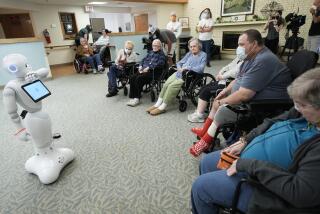Quality Control Moves Into Nursing Homes : Health care: A UCLA gerontologist finds success at Reseda facility using techniques taken from factory assembly lines.
- Share via
What’s good for General Motors is good for nursing home patients.
That is what UCLA gerontologist John F. Schnelle learned when he applied quality control techniques from factory assembly lines to nursing homes.
His methods involve keeping detailed computerized records on patient mobility, nursing home noise levels and incontinence so corrective action can be taken as soon as any deviation from norms is spotted.
“That’s exactly what they do at General Motors,” he said.
Schnelle’s work is a faint glimmer in the generally dismal picture of nursing homes, which are plagued by substandard care, high staff turnover, poor wages and low morale.
He has had success at the Jewish Home for the Aging in Reseda, where he is director of the Borun Center for Gerontological Research, and at nursing homes in Iowa, Alaska and New Hampshire.
And it all sounds so simple.
Take the common problem of patients who are unsteady on their feet and likely to fall, resulting in the need for restraint belts.
First, Schnelle measures mobility. How long can a patient walk? Thirty seconds? One minute? Two minutes? The time is recorded and the patient is put on an exercise program and systematically retested.
Improvements are recorded and danger signals are immediately spotted: If a patient who can usually walk for two minutes is suddenly able to walk for only 30 seconds, the staff knows something is wrong.
“It’s the same thing in a factory,” Schnelle said. “You’re making fenders and suddenly they are off by one millimeter more than you would expect. You don’t know why. It could be the machinery. Or the worker is doing something wrong. The point is you want to be in a position to determine as soon as possible that something unusual is happening.”
*
Schnelle is also developing a technique to reduce noise that robs patients of sleep at night.
Equipment is being installed to detect noise in patients’ rooms and print out the information on graphs at nurses stations. The information will show where and when unusual noise occurs and enable staff members to control it.
Incontinence is another persistent problem Schnelle is working on.
All too often, patients who are unaware of what is going on are taken to the bathroom more or less on a regular schedule and then their beds are routinely changed when they are found to be wet.
Schnelle is trying to approach that problem systematically.
The first step is to identify those who can respond to being taken to the bathroom--usually about one-third of the residents. Those patients are taken to the bathroom regularly and then checked to see how frequently they wet their beds.
Staff members record that information and are quickly able to spot any deviations. The staff might find that patients’ beds are wet 10% of the time. If that changes significantly, the staff knows something is wrong--perhaps illness, perhaps neglect.
Cecile Menard, director of marketing and resident relations at Lemire Enterprises, which operates five nursing homes in New Hampshire, is pleased with what Schnelle has accomplished.
“I highly recommend it,” she said. “With the computerized program, you have the quality checks and the data that tells you how you are doing.”
At two of the company’s nursing homes in Manchester, Schnelle’s techniques cut the incontinence rate from 30% to 5% among targeted patients, Menard said.
She said there has also been an important side benefit: Patients can better cope with depression, a common ailment in nursing homes.
“One specific lady,” said Menard, “had been extremely agitated and difficult for the staff to manage and, through this program, her entire personality has changed. She is just pleasant and smiling and has become a joy to the unit.”
The woman’s behavior, Menard said, turned out to be based on an agonizingly simple problem: She needed to use the bathroom but did not know how to tell the staff.
*
The methods work, Schnelle said. The problem is finding a way to keep the staff from abandoning the techniques.
In an experiment in 1993, Schnelle’s team trained staffs at eight nursing homes nationwide. The homes were hooked up by computer to the Borun Center, and nurses aides at the facilities logged in the incontinence findings and spotted deviations from expected rates.
In six of the eight homes incontinence was significantly reduced during the six months that Schnelle closely monitored the programs.
But when the experiment and the monitoring ended, all but one home stopped using the new techniques. The reason, said Schnelle, is that staff members had been relying on program monitors for encouragement.
Positive feedback is crucial for maintaining the cooperation of nurses aides, he said, because these poorly paid employees who administer the program are being asked to work much harder with patients who are frequently incapable of even expressing a thank you for the extra effort.
“There is a large gap,” said Schnelle, “between getting my staff to come in and do it and getting nursing home staff to do it.”
He does not expect his techniques to be commonly used by nursing homes until the health care industry realizes they are cost-effective.
The methods will save money, he said, because they reduce incontinence and immobility, which are related to bedsores and respiratory ailments--problems that often require expensive hospitalization that is frequently paid for with public funds.
“If this program can prevent a small percentage of these hospitalizations, then it’s a savings,” Schnelle said.






